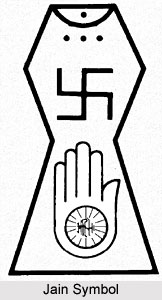 Lord Mahavira is the twenty-fourth Jain Tirthankara. Though he was born with worldly comforts and luxuries; he always remained detached from them. He became an ascetic at the age of thirty. He spent most of his time in austerity and in meditation for twelve and a half years. At the age of forty-two he attained omniscience, Kevalgyan. He thus became a Jina. During his life Mahavira organised a systematic religion and philosophy. He laid down a social order for his large group of followers. He revived the religious order consisting of monks, nuns, Shravaks and Shravikas. This order is known as the Jain Sangh. The first disciple of Mahavira called was Gautamswami. The Sangh helped in strengthening the structure of his organisation.
Lord Mahavira is the twenty-fourth Jain Tirthankara. Though he was born with worldly comforts and luxuries; he always remained detached from them. He became an ascetic at the age of thirty. He spent most of his time in austerity and in meditation for twelve and a half years. At the age of forty-two he attained omniscience, Kevalgyan. He thus became a Jina. During his life Mahavira organised a systematic religion and philosophy. He laid down a social order for his large group of followers. He revived the religious order consisting of monks, nuns, Shravaks and Shravikas. This order is known as the Jain Sangh. The first disciple of Mahavira called was Gautamswami. The Sangh helped in strengthening the structure of his organisation.
First Order
Mahavira formed a community of fourteen thousand monks and placed them under the charge of Indrabhuti. He formed the organisation to regulate and control those temptations and dangers which set upon the ascetics during their wandering life. For it, he divided the fourteen thousand monks into nine schools called Ganas. He placed each school under the leadership of one of his chief disciples or ganadharas. Each Ganadhara depending according to their rank had two hundred and fifty to five hundred monks under him. These teachers guided and instructed separate groups of Nirgranthas.
Second Order
The second order consisted of women followers. They were almost thirty six thousand in number. They had renounced the world and became nuns.
Third Order
His third order comprised of pious laymen or Sravakas. They were almost one lakh and fifty nine thousand and their head was Sankha Sataka. These laymen were required to follow the five anuvratas. The Sravakas were not required to renounce the world. The Sravakas and the monks followed many similar religious duties that brought them close to each other and helped them develop a bonding. The laymen thus could enjoy the life of a monk without renouncing the world.
Fourth Order
The fourth order comprised of devout laywomen or Sravikas. They were about three lakh and fifty eight thousand with Sulasa and Revati at their heads. The women remained engaged in their regular household chores and also served the ascetics in different ways.
Apart from the four orders there were almost three hundred sages, who were well versed about the fourteen Purvas, sages who possessed the Avadhi knowledge and kevalins who had the best of knowledge and intuition. There were also sages of high intellect who were acquainted with all the thoughts and feelings of all living beings. Many people belonging to the order could resolve their lives and acquire liberation. It is thus quite eminent that Lord Mahavira could convert a large number of people to Jainism.









